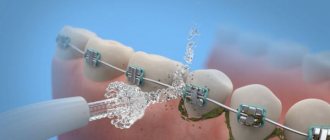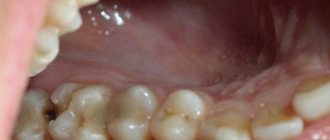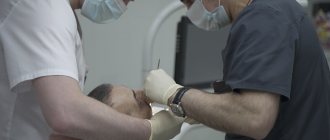Possible causes Problems with the crown on the pin The crown on the implant is loose Temporary crowns How to eliminate risks
“ Doctor, my crown on my tooth is loose, what should I do?
” This question is not uncommon in the dental office. Patients do not always understand why, instead of simply fixing the crown, the doctor prescribes an examination.
The orthopedist’s task is not just to fix the prosthesis, but to find out the reason why the crown is loose after installation.
Without an examination, it is impossible to make an accurate diagnosis, and if the cause is not eliminated, the problem will arise again and again.
The crown on a tooth has become loose - what to do? What could be the reason and how to solve this problem
In case of severe destruction or even complete absence of a tooth, the best option would be to restore it using an artificial crown - supported by a pin or stump inlay, or with the preliminary installation of an implant if the root system is missing. When using high-quality materials and following the technology for performing the procedure, such a single prosthesis will hold firmly and successfully perform its functions for a long time. But if the crown is loose on the tooth, this may be due to an injury or poor treatment. Read further in this article about what to do in such a situation.
Rejection symptoms
Rejection of the intraosseous element is a serious complication leading to the loss of the metal pin. Usually, implant rejection is accompanied by quite eloquent symptoms:
- Swelling of the gums, which does not decrease within 5 days after the intervention, but, on the contrary, increases.
- Reddened mucous membrane around the artificial root.
- Severe pain that intensifies with any load on the structure.
- Bleeding of the gums around the implant for more than 4-5 days after implantation.
- Purulent discharge from a wound.
- The appearance of a putrid odor from the implantation area.
- Excessive mobility of the artificial root, exposure of its neck, subsidence of the gums.
- Deterioration in general health, increase in temperature.
A loose implant crown is a reason to urgently go to the dentist. Rejection is rarely treated. With such symptoms, the best option is to remove the implant from the bone with further drug therapy aimed at restoring the body and regenerating bone tissue.
Why can a crown become loose and what does the strength of cement depend on?
An artificial crown is a single prosthesis that can be fixed to a tooth stump, a pin, a stump inlay or an implant abutment. This is the optimal way to restore a badly damaged or completely missing tooth. If such a crown begins to wobble, there is always a reason. The prerequisite may well be an injury or a medical error made during prosthetics. Mobility of the prosthesis in the latter case is not the only possible complication. Often, poor-quality treatment leads to the development of inflammatory and purulent processes, the development of periodontitis and periostitis.
Inflammation may be the cause of unsteadiness
If the prosthetic device wobbles, this may also indicate changes in the structure of the tissues of the stump after grinding the tooth. During the preparation process, it is necessary to preserve the structure of living tissues, as well as provide abundant water cooling. Otherwise, the hard tissues being processed will overheat, which will inevitably affect their strength and elasticity. With such a clinical picture, soon after prosthetics, the artificial crown may become loose, and then the optimal solution to the problem would be a complete replacement of the structure.
The quality of dental tissue directly affects the strength of fixation of products and the adhesive properties of the dental cement used. For prosthetics to be successful, the doctor must take into account the characteristics of the patient’s bite, the current state of his gums and bone tissue. To do this, a comprehensive diagnosis is first carried out, including an X-ray examination.
How long can a bridge last?
The average lifespan of a bridge on natural teeth is 5 years. With good care and, what is very important, high-quality manufacturing from the beginning, it can last 7-10 years. Bridges on implants last longer - here 10 years is the minimum period, on average they last 15 years. If we consider zirconium dioxide prostheses on implants, they will last 15-25 years or more. Then they can be replaced, without changing implants.
Don't know what type of prosthetics to choose?
We will help in the selection, advise where to read more information and compare types of prosthetics.
Consultation with an orthopedic doctor in Moscow clinics is free! Call now or request a call
Working hours: from 9:00 to 21:00 - seven days a week
Why does de-cementing occur in some cases?
Before installing a single denture, the dentist covers the protruding ground part of the tooth (stump) with a special cap. The product can also be fixed with support on a pin or stump insert. Dental cement is usually used to secure structural elements. If the composition is not of sufficient quality, it will not be possible to achieve strong fixation. In such a situation, the mobility of metal ceramics may be due to the use of too thin or thick cementitious composition.
In other situations, loosening of an artificial tooth becomes a consequence of an incorrect bite if the specialist did not take this point into account before performing prosthetics. Mobility also occurs when small particles of food get under the cap, which is usually the result of incorrect preparation of the ledge or a loose fit of the product.
The photo shows the decementation of the tooth crown
The shape of the inner surface of such a cap must exactly correspond to the anatomical parameters of the stump. This is necessary to ensure tight contact of the product with the stump structure or dental tissues, depending on the method of installing the prosthesis. If the contact density is insufficient, the product will soon become loose and risk simply falling out.
Thus, among the main reasons for decementation, experts in the field of prosthetics identify the following prerequisites: inaccuracy in the shape of the cap or the crown itself, poor preparation of the stump and errors in its preparation, ignoring the characteristics of the bite, and the use of low-quality cement1.
Causes
The main reasons causing looseness of a crown or artificial root are:
- the crown has mobility relative to the abutment;
- the connection is damaged or the installation is not performed correctly;
- the implant is unstable, integration into the bone was unsuccessful.
The first two cases are resolved quickly; in many cases, damage to the crown is not required. It’s worse if the cause of looseness is a pin. Causes:
- medical error, the design was implemented incorrectly;
- recommendations for oral care are not followed;
- the Patient's health condition is poor;
- the presence of a number of systemic diseases.
The dentist's mistakes when screwing in the rod include:
- sterility was compromised during the operation;
- the bone is overheated during preparation;
- immersion in the alveolar region is incomplete;
- when screwing in, excessive force was applied to the tissue and implant;
- technology and features of prosthetics were carried out with errors.
How to solve a problem
If the crown is loose on a front or back tooth, do not try to remove it yourself. Only a specialist can do this correctly. After this, the doctor will carefully remove the cement and other elements of the system. After this, you will need to restore the shape of the stump or replace the stump tab. You will have to create a new single prosthesis and install it after all preliminary measures.
If the cause is a cyst
A cyst is a pathological neoplasm in the thickness of the gingival tissue, in the root region. As it grows and fills with purulent exudate, it provokes such unpleasant symptoms as pain with throbbing, inflammation and redness of the gums, the formation of a dense painful lump, increased body temperature and enlarged submandibular lymph nodes.
The photo shows a cyst above the crown
The appearance of a cyst after prosthetics is most often a consequence of the doctor’s negligence, neglect of the rules of asepsis and antisepsis. If you have aching, shooting pain, see a doctor immediately. You will have to take an x-ray to make an accurate diagnosis and prescribe appropriate treatment measures. Sometimes it is enough to remove the tumor surgically, possibly with resection of the root apex. In advanced cases, the tooth is completely removed and subsequent prosthetics are performed on an implant.
After removal of the cyst, the canals are re-treated within 7-10 days. In some cases, specialists prescribe antibiotics, treat the internal structures of the tooth with antiseptics, apply anti-inflammatory drugs and provide temporary prosthetics. Only after complete relief of the pathological process can a permanent prosthesis be installed.
Inflammatory process
If the denture is poorly fixed and a significant gap (more than 0.3 mm) remains between it and the gum, suitable conditions arise for the rapid proliferation of pathogenic microorganisms. Moreover, food debris will constantly get stuck in such a gap and plaque will accumulate. As a result, this will lead to redness and swelling of the adjacent gums - the development of an inflammatory process. Among its characteristic signs, experts identify the following symptoms:
- soreness,
- bleeding,
- severe swelling,
- increased reaction to mechanical and temperature stimuli,
- bad breath due to the addition of purulent processes.
Swelling and pus may form under the crown.
With such a clinical picture, urgent dental care is needed. First you need to find the source of inflammation and stop it. To do this, the doctor will remove the crown and carry out a comprehensive cleaning of the teeth from plaque and subgingival calculus. In the future, the patient will be prescribed antiseptic and anti-inflammatory drugs for self-administration: rinsing solutions (Stomatofit, Rotokan, Chlorophyllipt, Furacilin, etc.) and ointments (Solcoseryl, Cholisal, Asepta) etc.). Only after successful complex therapy will the doctor be able to perform repeated prosthetics.
If the crown falls out along with the implant
If the prosthesis has become mobile and it is installed on an implant, it is better to urgently see your attending surgeon. At any moment, the entire implant system can fall out and lead to other serious consequences, including inflammation of the jaw bone and the rapid development of osteomyelitis. If mobility and loss of the implant occurs due to the development of complications, for example, due to an inflammatory process, peri-implantitis or rejection of the structure, then you need to act very quickly.
The photo shows peri-implantitis
“When I placed my first implant, I encountered a complication. The tissue around the already installed rod became inflamed, and after about a month, that is, not immediately. I had to urgently remove everything and undergo quite a long treatment. I felt terrible then. Until now, no one has really explained to me what happened. I was given a new implant only six months later, and I had to pay the full amount for it again. A very bad experience, after that incident I changed clinics, but I forgot that one like a bad dream.”
Evgenia K., from correspondence on the 32top.ru forum
Usually the entire structure has to be removed, after which anti-inflammatory and antibacterial therapy is carried out. Perhaps, after stopping the pathological process, it will be necessary to perform osteoplasty - to replenish the atrophied areas of bone tissue. After such an operation, you need to wait from 3 to 6 months until the planted material has completely taken root. Only after this can we return to the issue of re-implantation.
Prosthetics, if supports have to be removed
Very often, over years of increased stress, the supporting teeth are so destroyed that they have to be removed along with the roots. They can also collapse even after a few months or a couple of years - if there were any undetected diseases before prosthetics (this has already been discussed above). Or, if the patient did not see a doctor for a long time, he endured unsteadiness and pain. After removal, you will need to install either a longer bridge and “prepare” new supports for it, or a removable denture.
“I had a metal-ceramic bridge installed on my front teeth a couple of years ago, but then suddenly it began to wobble. At first I didn’t attach much importance to it. Maybe it seemed like a little. But he staggered more and more, and his tooth began to ache. I went to the dentist. The verdict is to remove the tooth, there is a large cyst. I don’t understand where it came from.”
Stanislav, review from otzovik.com
But the best option is implantation. This way, it will be possible to preserve the remaining living teeth (and not use them for supports) and extend the service life of the new orthopedic structure. After all, dentures on implants last approximately 2 times longer than those installed on natural teeth.
Read on the topic: dental bridge on implants - what it is and who it is suitable for.
What can you do at home?
If you are unable to get an appointment with a specialist in the near future, before visiting the doctor you should ensure the maximum level of hygiene and also treat the problem tooth with care. As optimal antiseptic measures, rinsing with Chlorhexidine or Miramistin, tincture of propolis or calendula is recommended, especially if there are signs of an inflammatory process. Among traditional medicine, chamomile, sage, oak bark, and soda-salt solution have proven themselves to be quite good.
Chamomile decoction helps well in treatment
Treatment
Based on the examination of the tooth, the orthopedic dentist will select treatment.
First stage
— removal of the crown if there is an inflammatory process underneath it. When it is removed, it becomes deformed and cannot be reinstalled.
Second phase
— tooth canal treatment and sanitation are carried out. Conducted by a dental therapist. After this, an appointment is made with a prosthodontist, who will install a new crown or CEREC dental module.
The reason a living tooth reacts to hot and cold is caries. You know very well how caries is treated: the doctor uses a special bur to eliminate caries until the tooth tissue is clean. Next, if necessary, the tooth is covered with filling material.
If the so-called pain responds. a dead (previously pulpless) tooth without a nerve, then in this situation we can talk about an inflammatory process around the tooth. The dentist cleans the tooth, removes the filling material, and administers the medicine. Everything is not done in one visit. The patient is prescribed drug therapy. If at a subsequent visit there is no inflammation, then the canals are sealed and a permanent filling is placed. The tooth is ready for new prosthetics.
Preventive measures
To reduce the risk of the crown loosening and falling out, it is important to strictly follow the specialist’s instructions after the procedure, as well as maintain cleanliness and hygiene of the oral cavity. Here's what prosthetics experts recommend in this regard:
- brush your teeth twice a day, rinse your mouth after every meal, use floss. It is advisable to purchase an irrigator - a device that supplies a powerful air-water jet for better cleaning of hard-to-reach places. You can read more about the principle of operation of the irrigator and popular models of the device in our special article,
- follow some nutritional principles. For example, immediately after the procedure you will have to give up products that are too hard and stretchy. Subsequently, it is better to forget about the habit of gnawing seeds with your teeth and cracking the shell,
- It is better to quit smoking and drinking alcohol too often,
- treat the installed structure carefully and carefully, regularly check it for chips, cracks and other damage,
- When the first alarming symptoms appear, you should immediately consult a doctor.
To maintain your smile, proper dental hygiene is important.
After dentures, do not forget to visit the dentist every six months for preventive examinations and a professional. hygiene. At each such appointment, the doctor will evaluate not only the condition of the teeth and gums, but also the integrity and functionality of the installed dentures. If necessary, when the product’s expiration date approaches, a specialist will prescribe its timely replacement.
1Massironi, D. Precision and aesthetics. Clinical and dental stages of dental prosthetics, 2008.
Negative factors
The weakened position of the prosthetic structure placed on implants may be caused by one of the following factors:
- Displacement of the crown relative to the abutment;
- Displacement of the abutment in relation to the implant;
- Displacement of the implant in the bone structure.
Identifying the specific area where the problem arose is the first step towards solving it. In the case of the first and second factors mentioned, the main cause, as a rule, is a failure of fixation caused by the destruction of the cement base, rotation of the screw elements or loosening of the thread.
A much more serious problem is the third factor, which indicates rejection of the rod by the bone structure. Considering the complexity and duration of recovery of the body during implantation, an unsuccessful outcome of the operation causes a lot of inconvenience - both for the patient and the dentist. A similar situation may arise under the following circumstances:
- Failure to comply with the implant installation protocol;
- Failure to follow medical recommendations during the engraftment period;
- The presence of hidden systemic pathologies that have become a catalyst for rejection.
Regardless of the cause, at the first symptoms of an anomaly, it is recommended to immediately undergo additional examination using an X-ray machine or CT scan.









